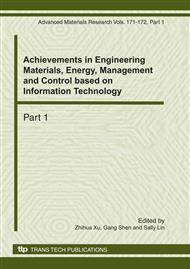[1]
A A Kuehn, M J Hamburger. A heuristicprogram for locating warehouses. Management, science, no. 9, (1963), p.643~666.
Google Scholar
[2]
Edited by Cai Xixian and Xia Shizhi. Quantitative methods for logistics rationalization,. Wu Han: Huazhong Polytechnic University Press, (1985).
Google Scholar
[3]
Lu Hua, Yang jiaqi. The application of fuzzypriority and heuristis algorithm in site choice of logistics center,. Journal of Wuhan University of Technology, Vol. 26, no. 3, (2002), p.389~392.
Google Scholar
[4]
Yang Bo. A randomized mathematic model of logistic system and allocation of its distribution center,. Chinese Journal of Management Science, vol. 4, no. 2, (2003), p.45 ~49.
Google Scholar
[5]
Li Dengfeng. Fuzzy multi-objective multi-person decision making and countermeasures,. Beijing: National Defence Industrial Press, (2003).
Google Scholar
[6]
Yang Lunbiao and Gao Yingyi. Principle and application of fuzzy mathematics,. Guangzhou: South China University of Technology Press, (2005).
Google Scholar
[7]
Chanas S, Kuchta D. Multiobjective programming in optimization of the interval objective functions—A generalized approach,. European Journal of Operational Research, no. 94, (1996), p.594~598.
DOI: 10.1016/0377-2217(95)00055-0
Google Scholar
[8]
Ishibuch i H, Tanaka H. Multiobjective programming in optimization of the interval objective function,. European Journal of Operational Research, no. 48, (1990), p.219~225.
DOI: 10.1016/0377-2217(90)90375-l
Google Scholar
[9]
Tong S. Interval number and fuzzy number linear programming, .Fuzzy Sets and Systems, no. 66, (1994), p.301~306.
DOI: 10.1016/0165-0114(94)90097-3
Google Scholar
[10]
Liu Xinwang, Da Qingli. A satisfactory solution forinterval number linear programming, Journal of Systems Engineering, vol. 14, no. 2, (2003), p.123~128.
Google Scholar
[11]
He erya. Research on arithmetic in interval optimal model,. Wuhan University of Technology, (2005).
Google Scholar
[12]
Guo Junpeng; Wu Yuhua. Standard form of interval linear programming and its solution, Systems Engineering, vol. 21, no. 3, (2003), p.79~80.
Google Scholar


